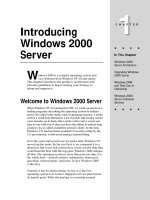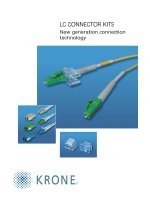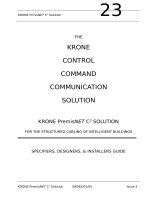Tài liệu Hartsfield-Jackson Atlanta International Airport doc
Bạn đang xem bản rút gọn của tài liệu. Xem và tải ngay bản đầy đủ của tài liệu tại đây (136.24 KB, 3 trang )
CASE STUDY
Hartsfield-Jackson Atlanta International Airport
CHALLENGE
Hartsfield-Jackson Atlanta International Airport (HAIA) is the world’s
busiest passenger airport, serving more than 83 million passengers per
year. As part of its mission “to be the world’s best airport by exceeding
customer expectations,” HAIA has continually enhanced its 5.8 million
square-foot facility. Part of that effort involves ensuring clear, reliable
communications services for passengers and airport personnel to ensure
a safe and productive environment.
THE UPGRADE PLAN
In 2000, HAIA management determined that the existing network
and telecommunications infrastructure was inadequate to support the
airport’s long-term vision. “When we looked at our current infrastructure
and considered our customer needs and where we wanted to go with
services, we found that there were major gaps, "says Lance Lyttle, HAIA’s
chief information officer. “The airport did not have an airport wide,
centrally managed, infrastructure with the required technology and
bandwidth to support future required applications.
”In addition, cellular telephone and public safety wireless coverage
was spotty, with dead spots and poor reception plaguing certain parts
of the facility. Although some cellular carriers had deployed their own,
in-building wireless distribution systems to boost their signals, other
carriers relied on nearby outdoor cell towers.
CASE STUDY
As a result of the analysis, the airport embarked
on a three phase, four-year, $11 million
telecommunications infrastructure upgrade
program that would bring state-of-the-art voice,
video, and data communications to every part
of the airport for passengers, employees, and
tenants. The program rolled out in three phases,
the first two of which involved building new
telecommunications rooms, raceways, conduits,
and cable trays and then installing a centralized,
OC-192 fiber-based backbone for all voice, video
and data traffic.
In the third phase, HAIA built value-added
services, including Wi-Fi access and pervasive
cellular and public safety wireless coverage.
CELLULAR COVERAGE REQUIREMENTS
Some public facilities rely solely on wireless
service carriers to deploy and manage in-building
systems. However, as part of its wireless neutral-
host strategy, HAIA chose to build its own system.
The objective is to ensure the highest quality
service and coverage for both cellular and public
safety systems, along with the ability to add
new services as they became available. Although
several companies supply in-building wireless
systems, HAIA’s evaluation team worked directly
with cellular carriers for over a year to select,
design, and implement a system that would meet
everyone’s needs.
“We wanted a proven system that would support
multiple providers – a system that had the
carriers’ confidence,” says Lyttle. “We actually
had weekly meetings with Cingular, Nextel,
T-Mobile, metroPCS, Verizon and other carriers
during our evaluation of technology options to
make sure their requirements were met.”
As with most in-building systems, the deployment
included on-site base stations from cellular
carriers. These base stations are located in the
airport’s new “telecommunications hotel,” and
the wireless signals would be propagated from
them throughout the airport via a distributed
antenna system (DAS). Given the size of the
facility, the HAIA team wanted a DAS that could
distribute wireless coverage evenly, without signal
loss, regardless of the distance from the carrier
base station. In addition, the team wanted a
system that could easily support the airport’s high
customer volume and could be cost-effectively
deployed and upgraded to support additional
capacity and new wireless services.
THE SOLUTION
The evaluation team eventually chose the
InterReach Unison
®
system.
The Unsion system uses a familiar hub-and-spoke
architecture, much like that of an Ethernet
LAN. At HAIA, the deployment involved eight
separate Unison systems that included 36 Main
Hubs, 96 Expansion Hubs, over 500 active
Remote Access Units (RAUs), and more than
700 ceiling-mounted antennas.
Due to its size (one of the largest systems in the
world) and a design change during deployment,
installation and testing of the Unison system
took about six months. It went live in
mid-January 2006.
CASE STUDY
Website: www.adc.com
From North America, Call Toll Free: 1-800-366-3891 • Outside of North America: +1-952-938-8080
Fax: +1-952-917-3237 • For a listing of ADC’s global sales office locations, please refer to our website.
ADC Telecommunications, Inc., P.O. Box 1101, Minneapolis, Minnesota USA 55440-1101
Specifications published here are current as of the date of publication of this document. Because we are continuously
improving our products, ADC reserves the right to change specifications without prior notice. At any time, you may
verify product specifications by contacting our headquarters office in Minneapolis. ADC Telecommunications, Inc.
views its patent portfolio as an important corporate asset and vigorously enforces its patents. Products or features
contained herein may be covered by one or more U.S. or foreign patents. An Equal Opportunity Employer
105917AE 2/08 Original © 2008 ADC Telecommunications, Inc. All Rights Reserved
SYSTEM PERFORMANCE AND CUSTOMER SATISFACTION
The Unison system now delivers clear, high-quality voice and data services to every area of the airport,
including ticket lobbies, baggage handling areas, gates, and throughout the underground passenger
transportation system. It currently handles traffic for all wireless subscribers as well as the airport’s public
safety workforce.
With a current capacity of nearly 70,000 calls per hour, HAIA’s travelers can use their time more
productively for untethered voice and data calling. Already, Verizon has deployed its new 3G mobile
data service (using EV-DO) for users of its wireless laptop cards, who are enjoying connection speeds
of up to 900 Kbps. The other carriers are planning high-speed data service upgrades as well. The
new system has also eliminated coverage gaps for security personnel, ensuring continuous contact in
elevators, stairwells, or anywhere else in the facility.
Now at the completion of its telecommunications upgrade program, HAIA boasts a cellular wireless
infrastructure with service and coverage second to none—an asset that's only fitting for the world's
largest passenger airport. Thanks to ongoing improvements and premium technology partners,
Hartsfield-Jackson Atlanta International Airport is poised to continue its industry leadership.









